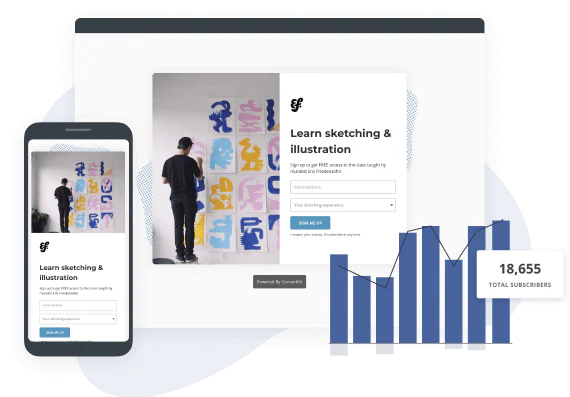In this Article
Electronic press kits (EPKs) can land you gigs, market your music, and promote your brand.
But piecing together an EPK can be overwhelming.
To make the process easier, we put together this guide. We’ll even tell you where to find a free EPK template that you can fully customize to match your aesthetic.
By the end, you’ll have everything you need to make an EPK that opens more doors for you.
What is an electronic press kit—and why do musicians need one?
An electronic press kit is a resume for musicians, bands, artists, and other musical creatives. It’s a tool to present an artist’s brand, music, and career highlights in an organized way.
EPKs usually include elements that other industry professionals want to see. Like your songs so people can get a feel for your style. Or images of you performing that the press can use to accompany the articles they publish about you.
They also help people better understand your talents and who you are as an artist or group. Which can help you get discovered, book gigs, and advance your career.
EPKs are essential for musicians. After all, industry professionals use EPKs to get to know an artist and their music.
And although your music might speak for itself, industry insiders may not listen to all your tracks to get an understanding of who you are.
Instead, they want to gather deep insight all in one place. Whether it’s to book a gig or write a feature, your EPK can provide insight for people to learn more about you as an artist.
The 13 things musicians should include in their electronic press kit
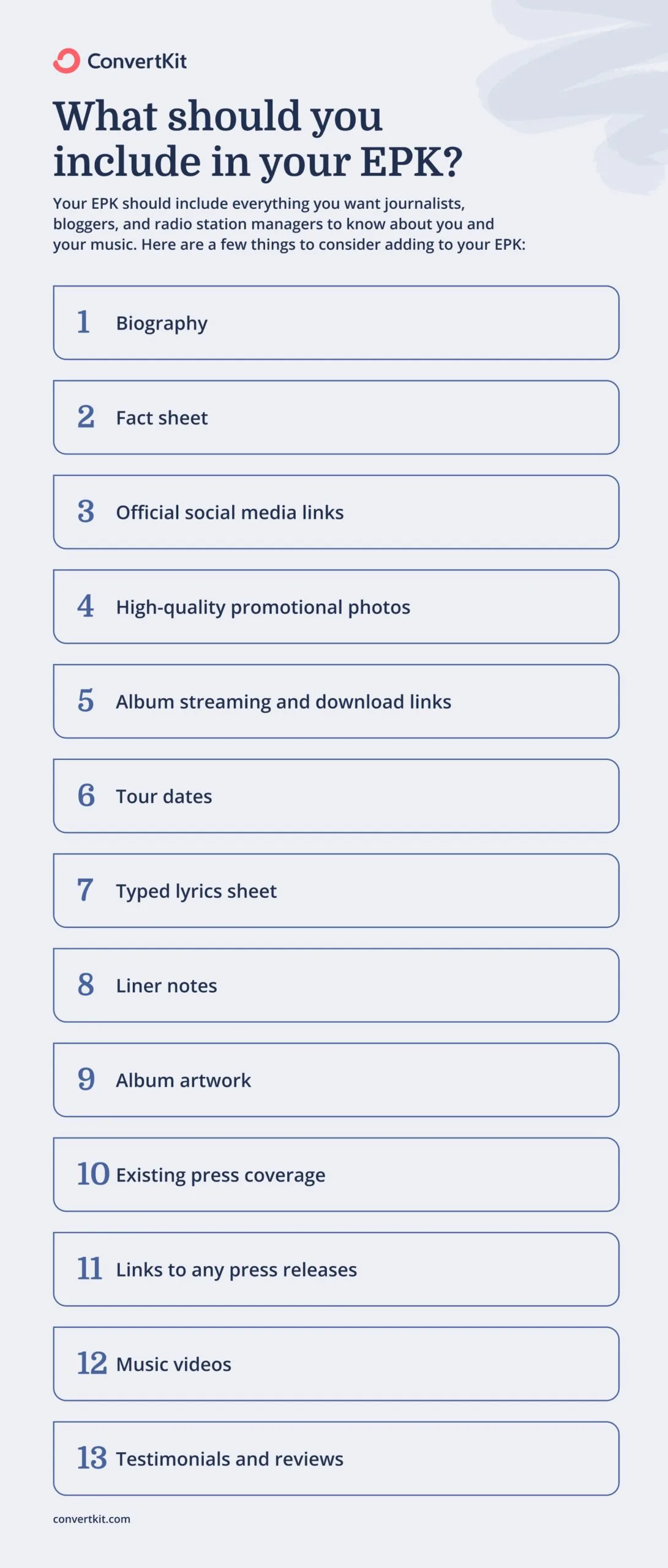
Every press kit should include these 13 elements. We recommend collecting these items before starting your EPK.
Then, after gathering what you need, plug everything into an EPK template. Your EPK will be ready in no time.
1. Biography
Your biography sets your EPK’s tone. It tells the world who you are, what drives you, and how your music was born.
Your bio can include:
- Where you’re from originally
- Where you’re currently based
- What music inspired you
- What inspired you to create
- Previous musical projects
- What it was like creating your album or EP
- What motivates you
- Themes to listen for on the record
Some artists opt to write their bio. Others feel too close to their own projects and hire out.
If you hire a publicist, they’ll likely write a biography for you, but there are also writers who can write a bio for a few hundred dollars.
Just search queries like “musician bio writer” on Google to pull up these services.
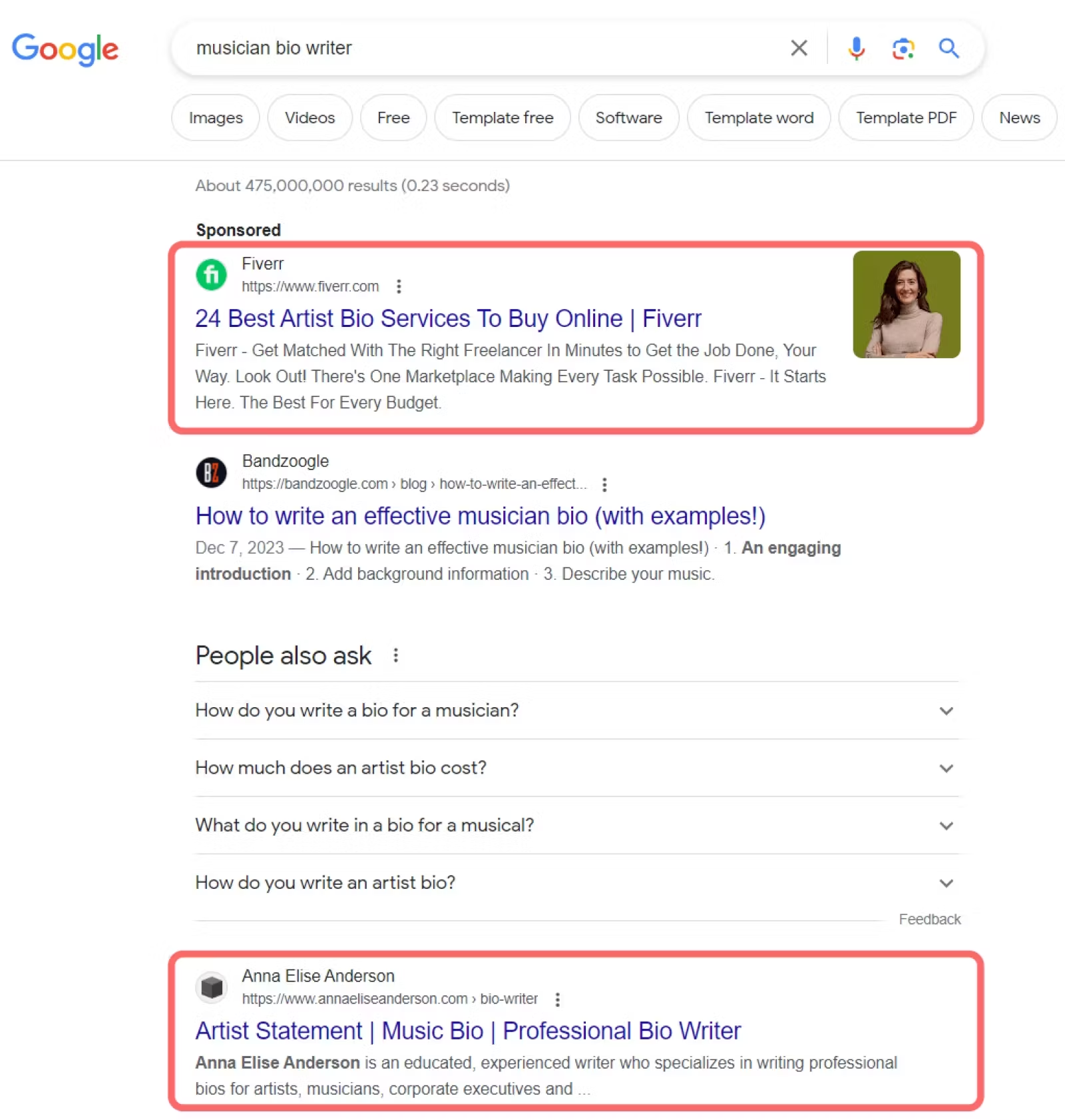
If you want to have a go at writing your own bio, go through our writing exercises. These will help you think outside of the box so you can write a bio that pulls in your reader.
2. Fact sheet
A fact sheet is your biography boiled down to its key points.
Fact sheets are ideal for highlighting info that people might miss if they choose to skip over your bio. Consider including:
- Location
- Band name
- Band members (names and instruments)
- Genre
- Key points of interest: influences, performance style, notable facts (i.e., bands toured with, impressive existing press, etc.)
- Record label
- Contact information
- Booking agent
- Manager
Artist Meli Levi lists their facts in short points so people can scan and gather the info they need without needing to read their entire bio.
3. Official social media links
Add social media links to the top of your EPK so journalists don’t have to dig to find them.
Singer Clarissa Diokno has social icons near the top of her EPK. She also adds the number of followers she has for each social platform to give viewers a glimpse of her reach.
4. High-quality promotional photos
Adding high-quality images to your EPK gives industry professionals—particularly the press—a place to gather media of you to use in promotional materials.
Try to include at least two looks (outfits and locations) as well as images that would work well cropped to square, horizontal, and vertical, like singer Parissa Bouas does:
Images should be at least 1,200 pixels wide or tall and taken with a DSLR camera.
DSLR cameras often capture greater detail and produce higher-quality imagery compared to photos taken from a phone.
To keep this section fresh, rotate in new photos every few months. Otherwise, the press will use the same few photos, which can feel stale.
5. Album streaming and download links
Embedding an unlisted Soundcloud player into your EPK gives journalists a way to hear your music.
You should also include a download link for those who’d prefer to drop your music into their own media players, like iTunes.
Singer Zenia Marshall offers different options for people to listen to and download her music:
Include downloadable links for instrumental versions of album tracks and approved clips to use in promotion. Instrumentals are especially helpful if you use your EPK to pitch synchronizations for TV shows, movies, and commercials.
6. Tour dates
A list of tour dates helps local radio stations and journalists prioritize when and how to cover your music.
If you’re touring with another band, make a note of that as well. If you can, add local openers, as that can help you get coverage for local shows.
Singer Chancey Williams features his upcoming shows. He also has buttons so people can follow his tours, buy tickets, or get reminders for his shows:
7. Typed lyrics sheet
A typed lyric sheet in your EPK helps journalists understand the meaning of your songs. It also prevents embarrassing lyric misquotes within media coverage.
But you don’t need to include your lyrics right on your EPK—doing that would take up too much real estate.
Instead, consider adding a downloadable link to your lyrics. Like singer Amanda Grace does:
8. Liner notes
Liner notes give additional context to your music. And can include:
- Songwriting credits
- A list of musicians who recorded on your record
- Information about the recording studio
- The names of recording engineers, producers, and mastering engineers
- Dedications
Artist Shannon Chapman’s EPK lists who she collaborated with and who mixed and mastered her songs:
9. Album artwork
Album artwork on your EPK visually shows your brand and tells a story about your work.
Include high-resolution images of your album, including the front and back cover art and any other images from the album design that the recipient of your EPK might want to see.
Singer Erik Lunde includes the front and back of his latest album on his EPK:
10. Existing press coverage
Press coverage validates your credibility as an artist.
Highlight three to five of your best pieces of coverage, including press from the current album, like singer TolumiDE does:
And remember to update your EPK with new press as it comes in.
11. Links to any press releases
Adding press releases to your EPK is a great way to keep insiders up-to-date on what you’re doing.
Here’s how artist Zoe from Earth displays recent press releases:
Zoe uses pagination to showcase her three latest press releases. This lets people easily access anything they might have missed while keeping her EPK neat and clutter-free.
12. Music videos
Music videos offer a visual representation of your talents.
Add a few to your EPK along with one to two of your strongest live performance videos. These can be especially helpful if you’re sending your EPK to promoters.
Singer Sally Louise embeds a YouTube music video on her EPK:
Embedding a YouTube video can also direct people to your YouTube channel and help them discover more of your music.
Plus, if you embed unlisted videos, you can see how many people watch your videos from your EPK.
If you notice your views are low, you might want to place music videos higher up in your EPK so viewers don’t need to scroll far down to find them.
13. Testimonials and reviews
Social proof, like testimonials and reviews, helps you build credibility as an artist—especially if they come from well-respected people in the industry.
Feature glowing words from two or three individuals, like singer Mel Lathouras:
How to create a free EPK template from scratch
You can create an EPK for free by using one of Kit’s landing page templates. (We call them “landing page templates,” but they’re versatile and can be used as a free EPK template for musicians, too!)
Our templates are customizable and easy to use. Even better, you can create a landing page without a website and don’t need to know any code to make something beautiful.
Here’s how the band Sundae Crush created an EPK from scratch using Kit (and how you can, too).
Step #1: Gather all your assets
Save your assets—like photos and lyric sheets—in a centralized location. DropBox and Google Drive are good options, as these platforms give you unique links to each asset.
Sundae Crush saves media like music files (MP3s), photos (JPGs and PNGs), and videos (MP4s) in their DropBox.
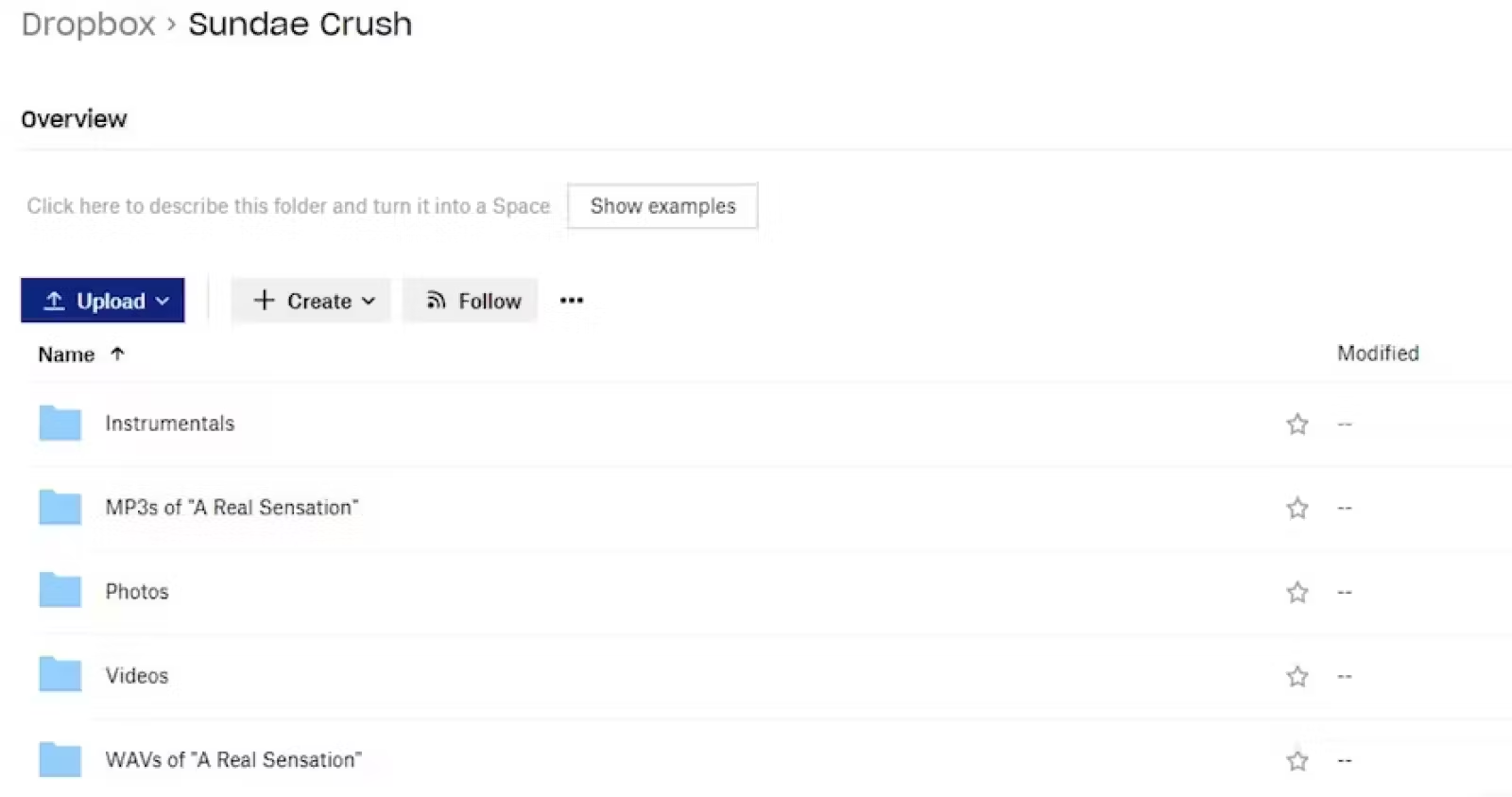
Then, add the links to your file folders to your EPK. Sundae Crush uses buttons that link to their DropBox assets:
Despite having all these different files uploaded to DropBox, you should format your EPK as a web page. This makes it easier for people to find your EPK through search engines.
For example, if you Google “shane cooley EPK,” Shane’s EPK (built with Kit) is the first result.

But people can’t search for your EPK if you leave it as a DropBox file.
Alternatively, you can make your EPK a PDF and put it on your website. Search engines might add public PDFs hosted on websites to the search results, but there’s no guarantee.
To give your EPK the best chance of ranking on search engines, it’s best to format it as a web page.
Step #2: Choose your electronic press kit template
After gathering assets, log into Kit to choose a landing page template.
If you don’t have a Kit account, sign up for free to follow along.
Once logged into Kit, click “Grow” > “Landing Page & Forms” in the top navigation.
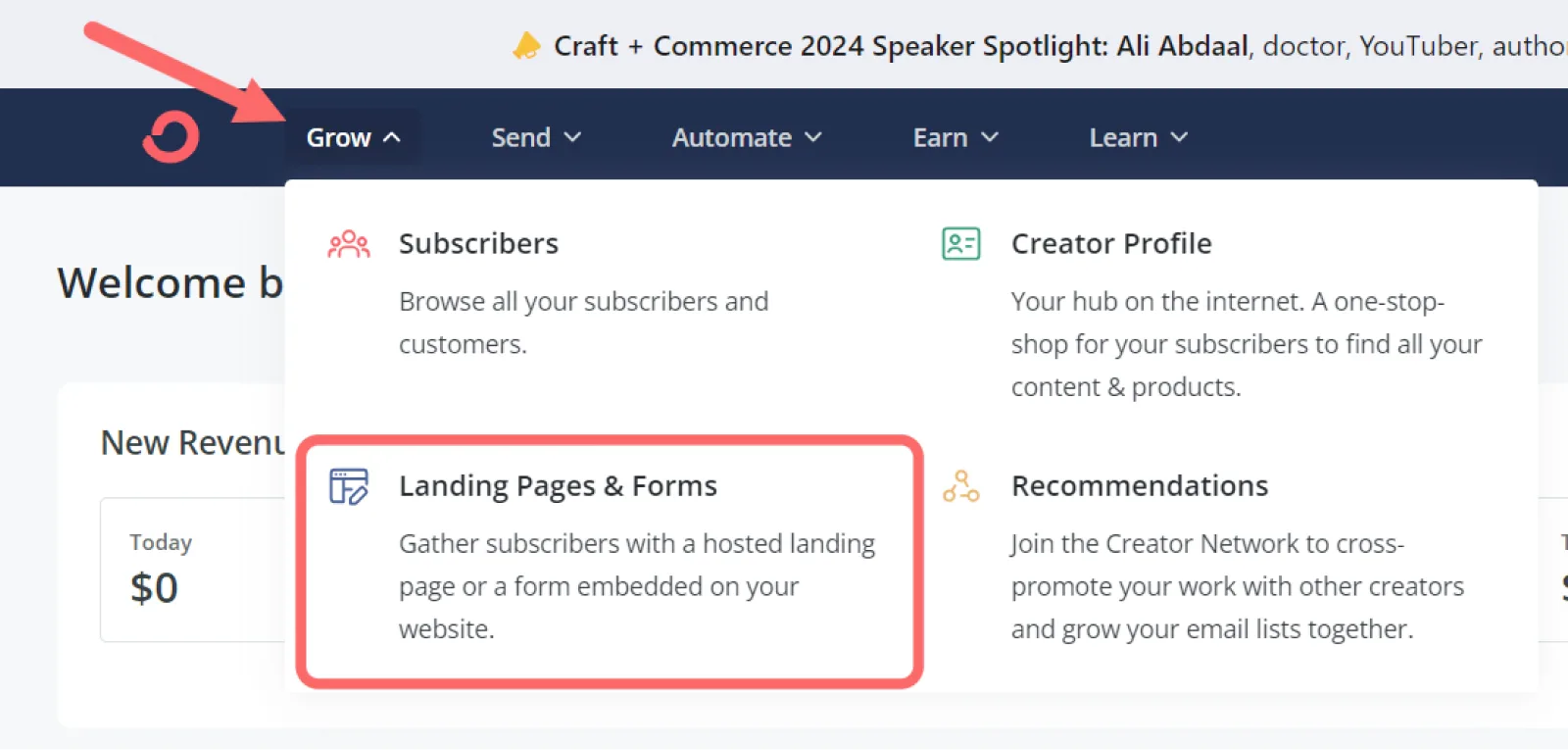
Then click the “+ Create new” button.

Finally, select “Landing Page.”
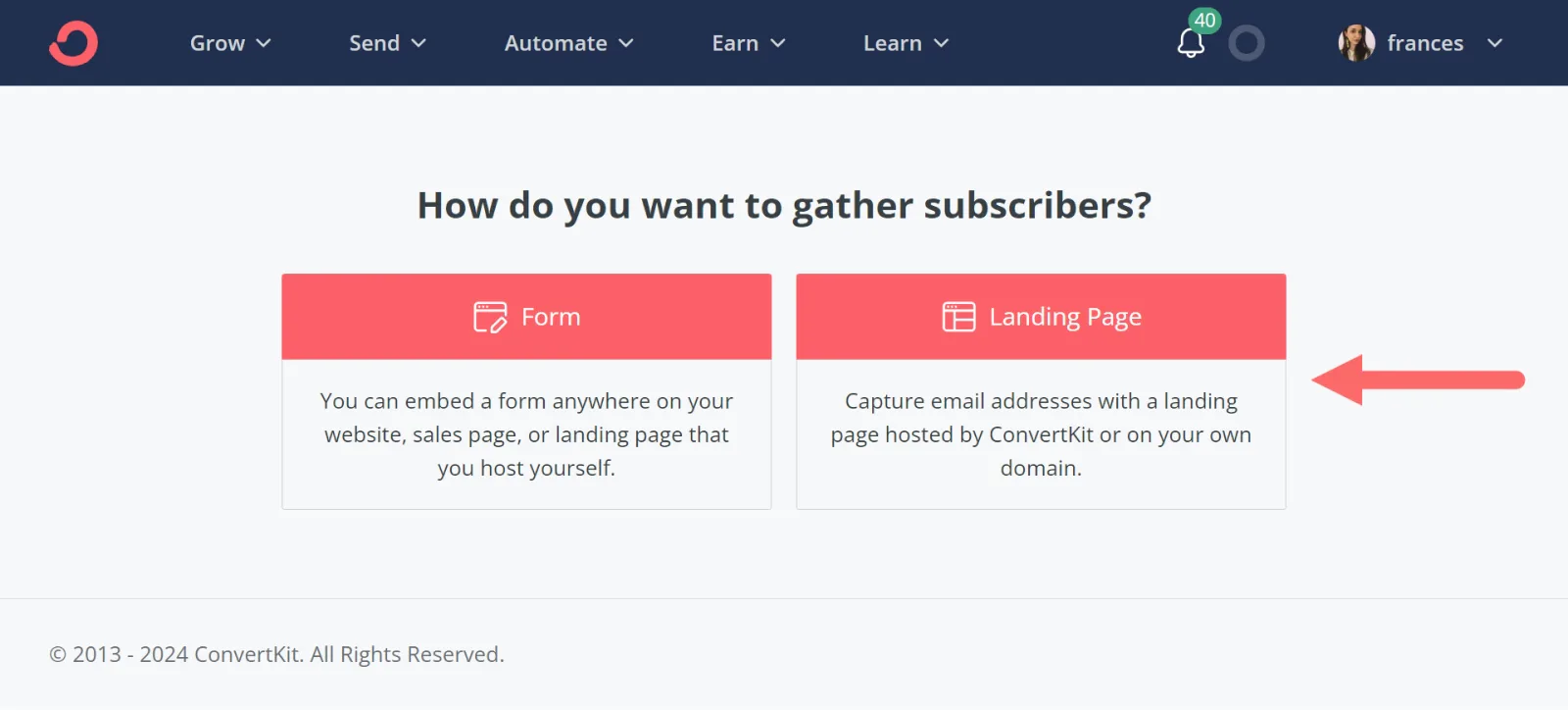
Browse our library of landing page templates and click “Preview” on any template to see how it looks on mobile and web browsers.
Pick the template that has a format you like. Don’t worry about finding one that matches your style—you can customize nearly every element afterwards.
Once you decide on a template, click “Choose” to edit it.
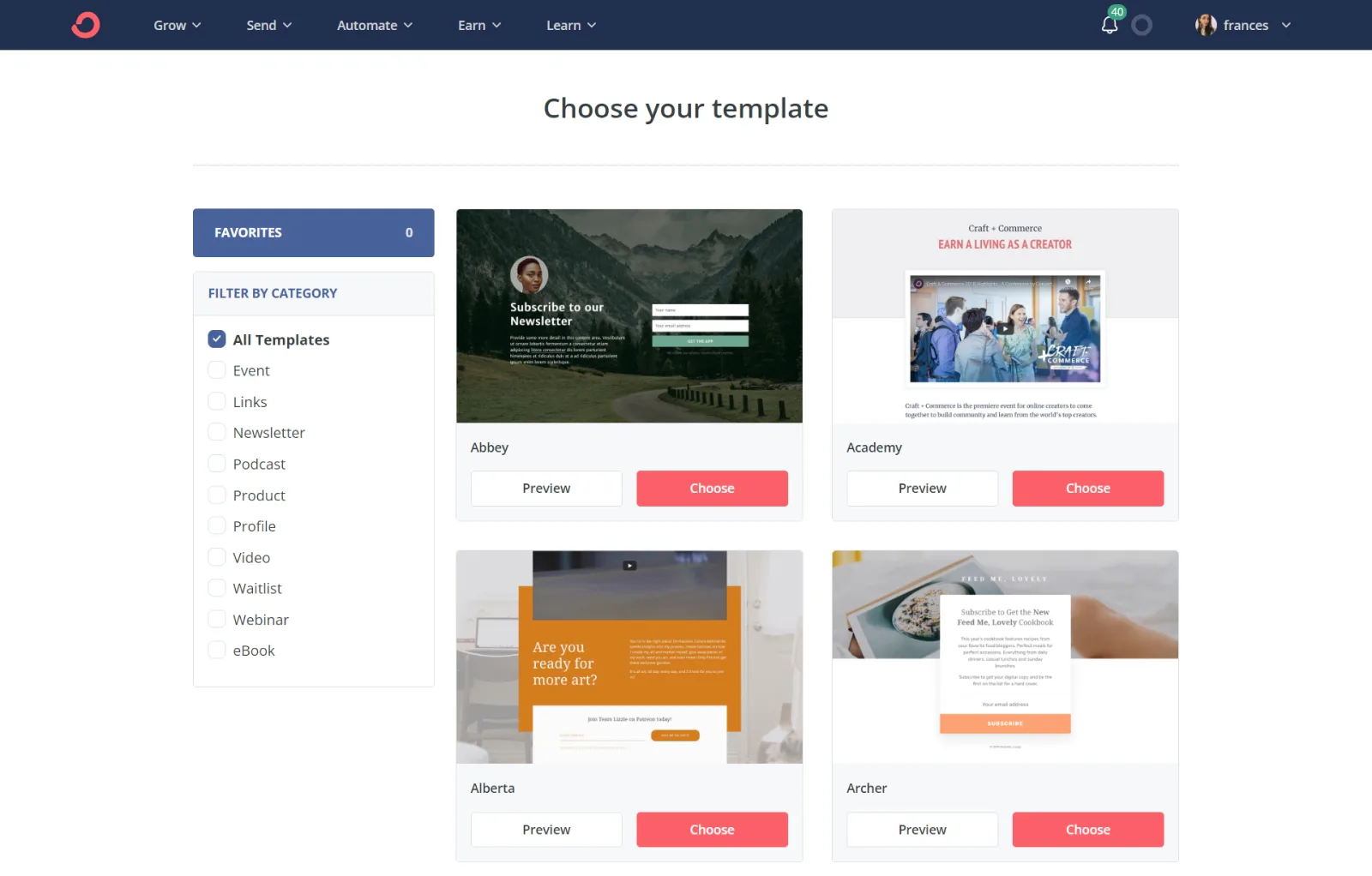
Step #3: Add your essential elements
Now it’s time to piece together your EPK by adding in everything listed above—like your bio, imagery, tour dates, and liner notes.
Edit existing elements on the EPK template by clicking them and replacing the element with your own assets. Adjust things like fonts, colors, and imagery to reflect your brand.
And click the “+” sign to access a drop-down menu to add elements like images, files, buttons, galleries, and more.
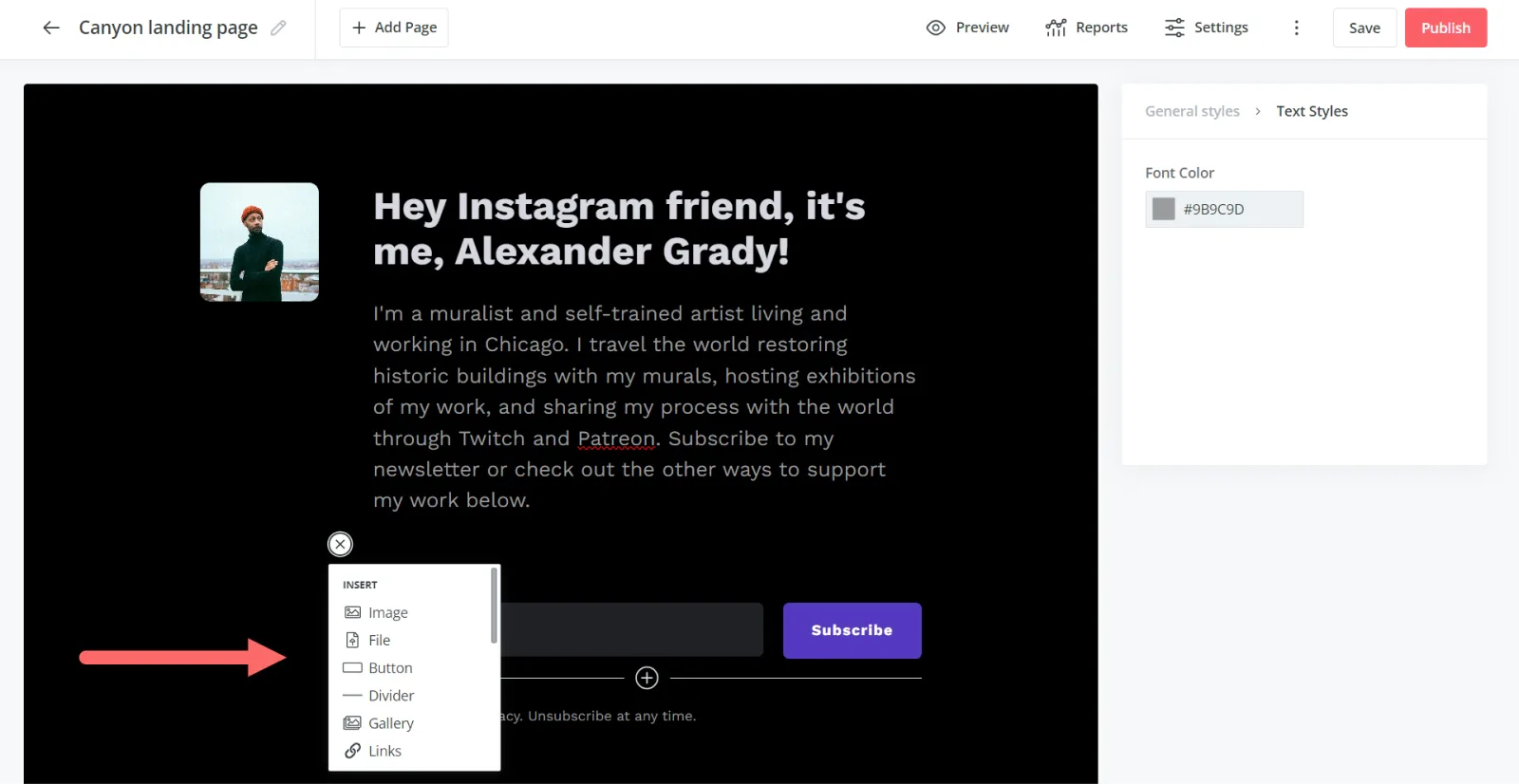
Here’s how Sundae Crush’s EKP looks after a few minutes of editing:
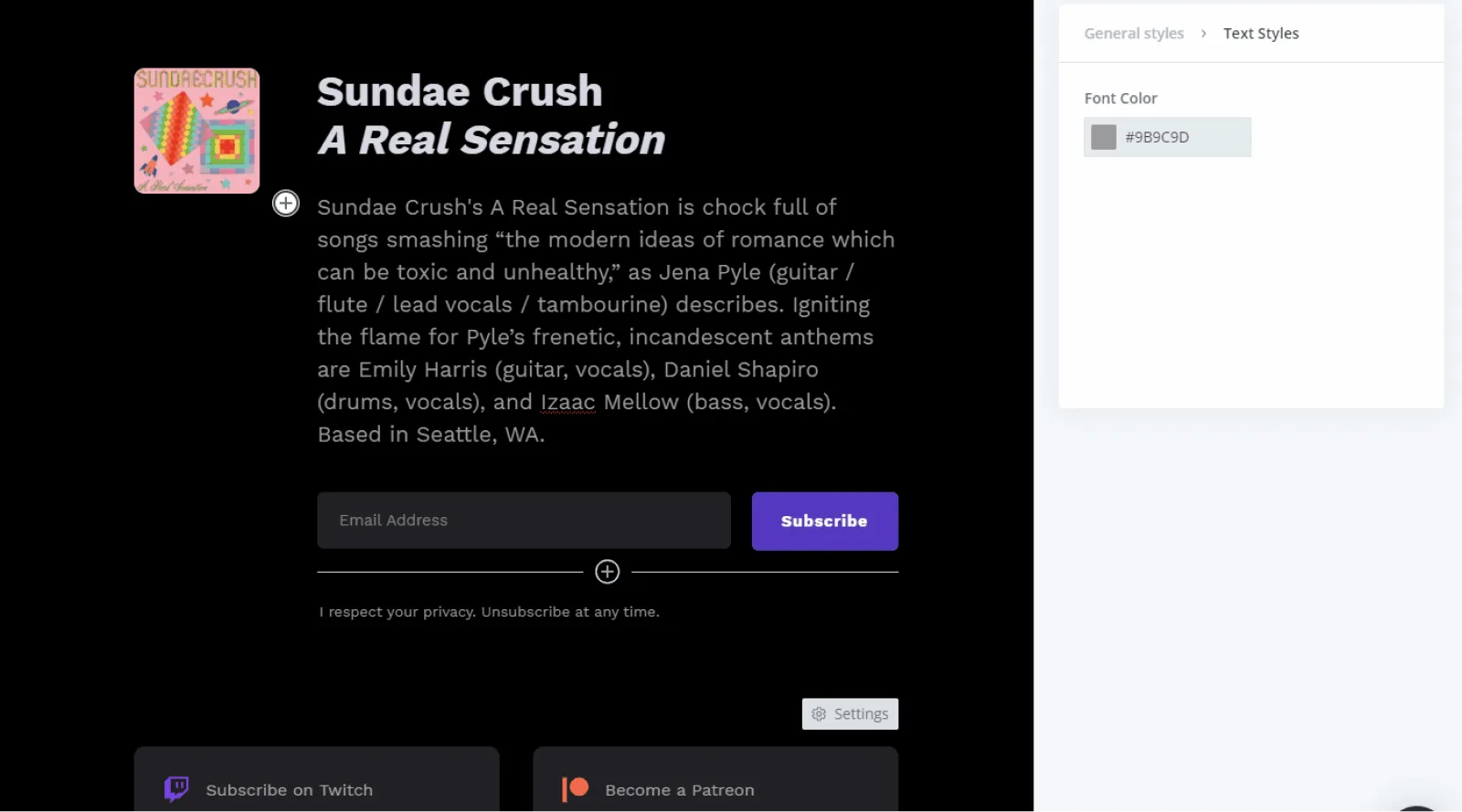
Step #4: Include a request for a physical copy
While most recipients of your EPK will be happy to stream your record, some prefer to listen on a physical medium such as a CD or vinyl. Some even prefer old-school tapes.
Kit’s landing pages all come with forms that ask for an email address. This form is perfect to request physical copies.
Add a row of header text above the form that says “Request a Physical Copy” and click the “+” below the email address field.
Since you’ll need to mail a copy, you should also add a field for a name and address. (Add more fields by clicking “+.”)
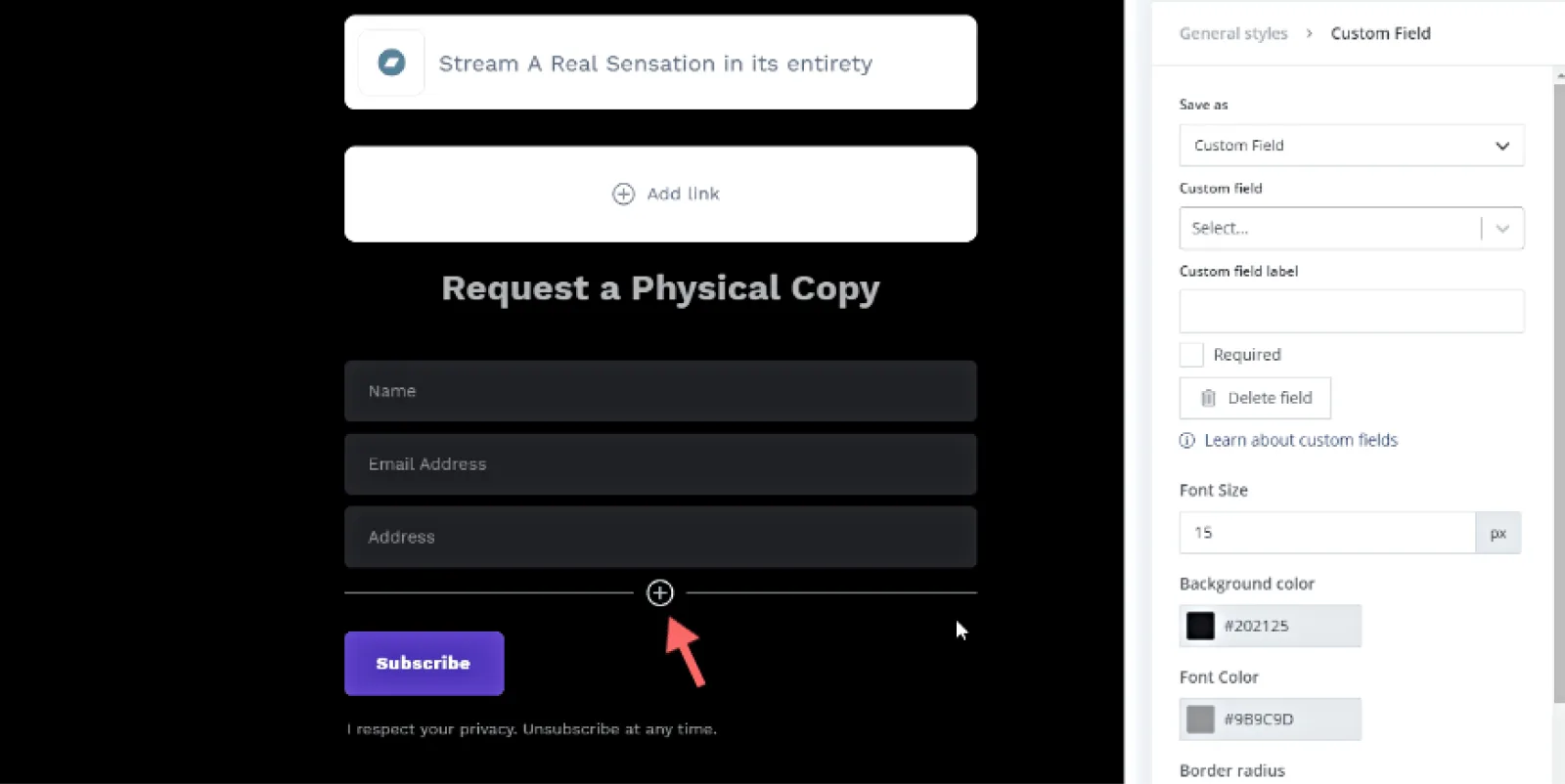
Sundae Crush also added a dropdown menu field (by clicking “+”) so users can choose which format they’d like (CD, tape, or vinyl).
Then, when someone submits their choice, Kit applies a tag to them. You can view these tags in your Kit account and see which format they chose (and send them what they requested).
Step #5: Make any final updates to your EPK template
Take this time to review what you’ve created and make sure every line of text, image, and button matches your style.
While building their EPK, Sundae Crush realized that the original black background on the EPK template didn’t match their aesthetic. But that wasn’t an issue since Kit’s landing pages are so customizable.
They decided to create a collage on Canva and upload it as their EPK’s background. That final decision helped Sundae Crush create an EPK that fully reflected their band.
What good EPKs look like: 6 top EPK examples from musicians
Professional EPKs range in style and formats. Some may take on a minimal style, while others feature more content to match their aesthetic.
Regardless of your style, a good EPK includes information about you, links to your social profiles, high-quality media, press coverage, reviews, album artwork, and your music.
These six examples highlight how great EPKs merge style and information to showcase who they are as an artist.
1. Example of Milck’s EPK
Artist Milck’s PDF electronic press kit is minimal and features high-quality imagery. Although her EPK is a PDF, she has uploaded it online so people can still find it through search engines.
Milck includes sections to discuss herself as an artist, career highlights, press, music videos, booking information, and social links.
2. Example of The Lagoon’s EPK
The band The Lagoons upload their EPK straight to their website. They’ve included information on their band, their influences, streaming highlights for added social proof, press coverage, music, and booking info.
3. Example of Joanna Teters’s EPK
Musician Joanna Teters also uses her website to host her EPK. On her EPK you’ll find album images, quality imagery, music videos, press, reviews, and more.
Joanna also links out to things like high-res photos and PDFs with her tour history.
4. Example of Gaz Price’s electronic press kit
Musician Gaz Price uses Kit to make his EPK.
He keeps his EPK concise with a short bio and includes links that direct people to things like his latest song, social profiles, press shots, and more.
He also includes an “upcoming gigs” section so people can find out where he’s performing live.

Image via Gaz Price
5. Example of Davey McGee’s EPK
Singer Davey McGee also used Kit’s templates to make his EPK.
His EPK includes a bio, social profile links, a fact sheet, links to his social profiles, high-quality imagery, and an area to subscribe to his email list.
6. Example of Hollandar’s EPK
Singer Hollander’s EPK features a variety of music videos and media, along with her bio, downloadable items, songs, reviews, and more.
She also adds buttons beside her most recent shows so people can buy tickets to watch her perform.
More EPK related tips and information
Let’s go over a few EPK tips to bring everything together.
Ways to promote your electronic press kit
Make it easy for industry professionals to view your EPK with these three methods:
Put your EPK at the top of someone’s inbox by emailing it to members of the media, talent buyers, venues, and other major players in the music business.
Find journalists, bloggers, and playlist curators that cover music similar to your band and email them the link to your EPK so they have it on file.
You can also add a link to your EPK in your email signature. Then, whenever you send an email, your recipient can access your EPK.
SEO
Optimize your EPK for search engines so that when someone searches things like “your name + EPK” it will show up in Google. Just like our earlier example from Shane Cooley.
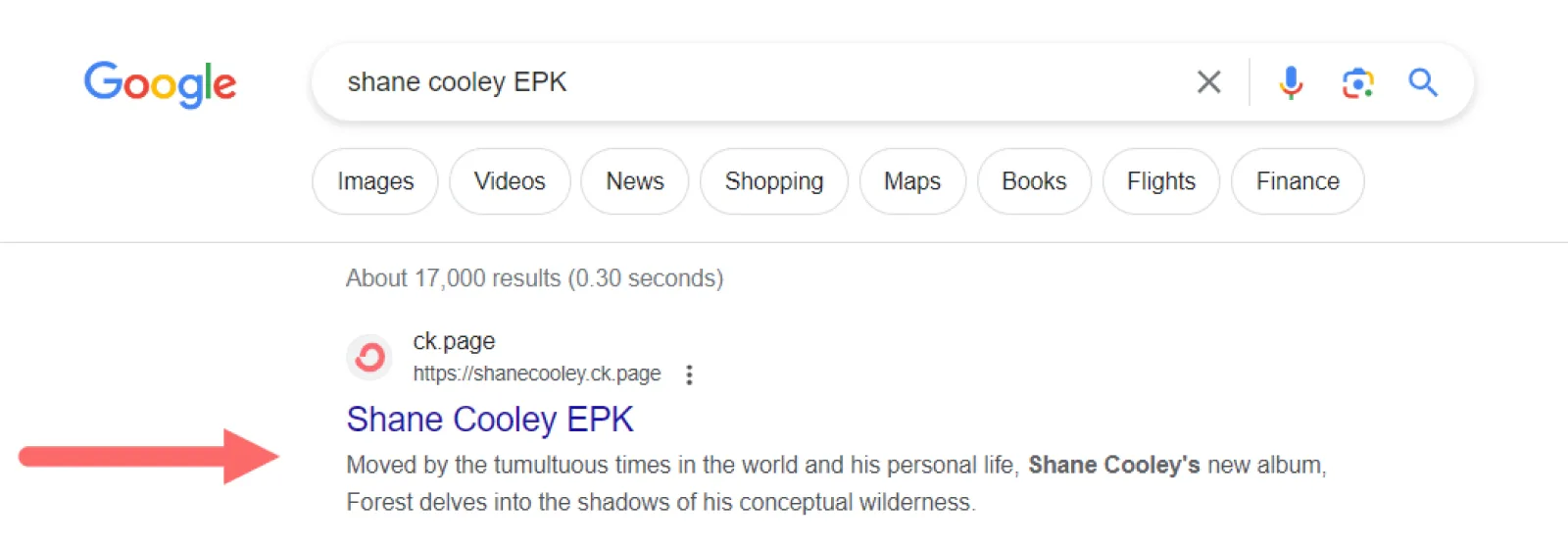
Include keywords within the copy of your EPK, like your name, your genre of music, and the words “electronic press kit” or “EPK” on your landing page.
Keywords tell search engines what your landing page is about. So, when someone searches for terms like “your name + EPK” or “your genre + EPK,” your EPK is more likely to rank in the search results.
These keywords will likely occur naturally within your EPK anyways, but it’s still good to double-check for them.
Social media
Include the link to your EPK within your social media channel links. Like this link in Milck’s Instagram bio:

Then, when industry professionals click your link, they can jump straight to your EPK to get the info they need.
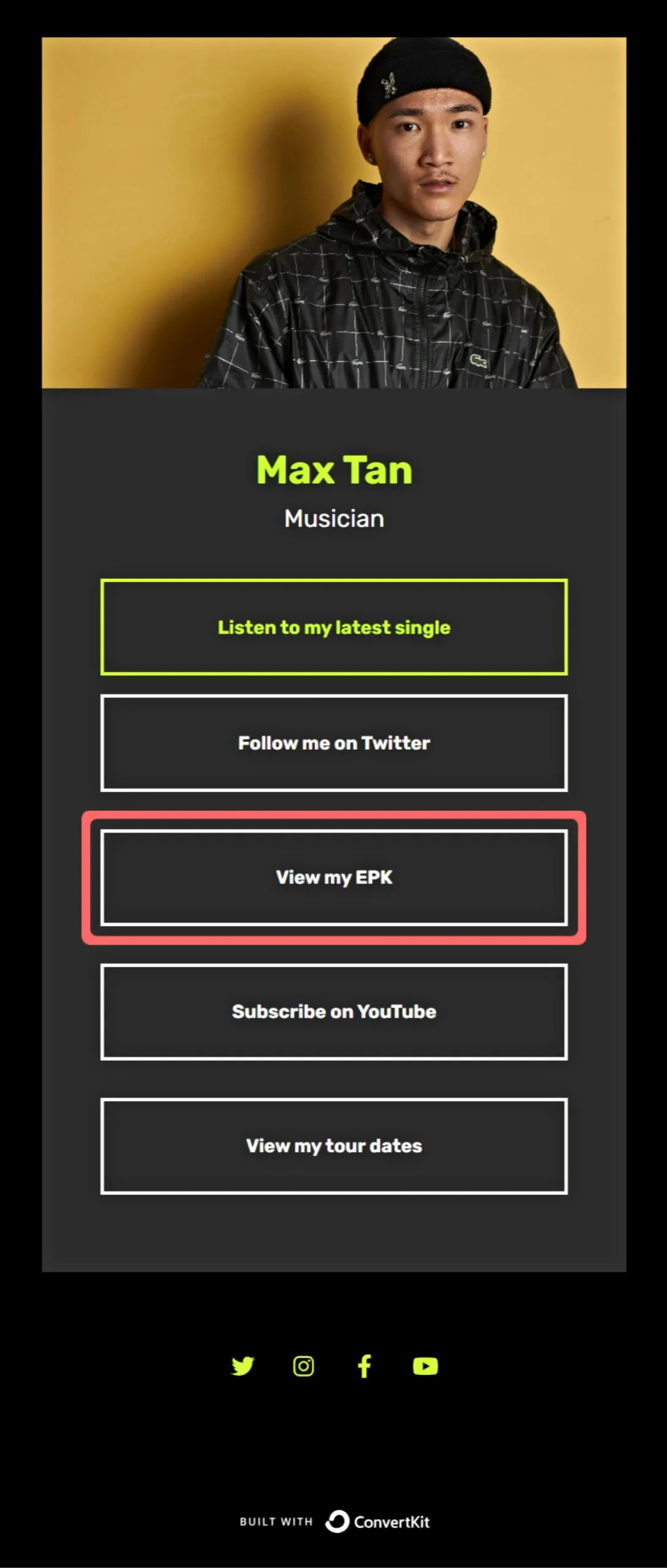
An example of a social media link page created in Kit.
Password-protect sensitive files
You deserve for fans to buy your music—not access it for free through downloadable links.
But EPKs often provide downloadable music files, which can give people a way to download your music for free.
The solution?
Password-protect sensitive downloadable files—like your music or lyric sheets to songs you haven’t released yet.
To do this, add a password to the folder where you upload your EPK files (like your Dropbox folder).
Then, share the password with industry professionals.
This way, you don’t need to worry about fans landing on your EPK and accessing files they shouldn’t.
Keep your electronic press kit up-to-date
Prevent your EPK from going stale by updating it regularly.
Sections you’ll likely want to update frequently are:
- Tour dates
- Media
- Songs
- Album artwork
- Press
These sections should reflect what you’re currently working on.
Other sections, like your bio, may not need to be updated as frequently. Check your EPK every few months to see if there are any areas you should refresh.
The price tag for a DIY EPK
DIY press kit options range from free to ~$50 per month, depending on which platform you choose to create and host your EPK.
For example, Kit has a free option (which includes the ability to create landing pages), meaning you can make an EPK at no extra cost.
You can also build your EPK on your existing website (if you have one). Doing this lets you use a service you’re already paying for.
On average, website hosting costs ~$20 per month (but can go up depending on your storage needs).
The downside to building an EPK on your website is that it’s often harder to customize your EPK since you may need to know HTML and CSS.
How much professionally created EPKs cost
Professionally-made EPKs can range from $195 to $795.
The cost depends on the designer and how much material you have to start with. Music marketer David “D4” Nguyen of D4 Music Marketing notes that:
A professional EPK starts with assessing what an artist has and what they’re missing. From there, the EPK is then designed from scratch with logos, photos, video, and other branding, and is sent to the artist or label for approval. – David Nguyen
This process takes anywhere from a few days to a few weeks.
When looking for an EPK expert to design your EPK, try to find someone who also specializes in EPK promotion. EPK designers with promotional skills can help your EPK reach the right people, so you can get more exposure and grow as an artist.
Keep in mind, you’ll likely pay a premium to work with someone who also has promotional skills on top of design knowledge.
Build your EPK for free with Kit’s landing pages
Your EPK can unlock opportunities and help you grow as an artist.
And with Kit’s landing page templates, you have everything you need to whip up a professional EPK (no coding required).
Want to give it a try? Build a free EPK with Kit, today.
























